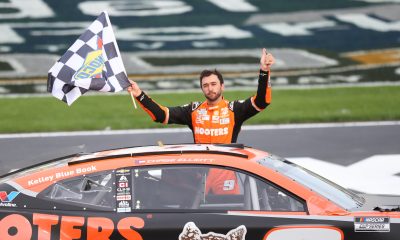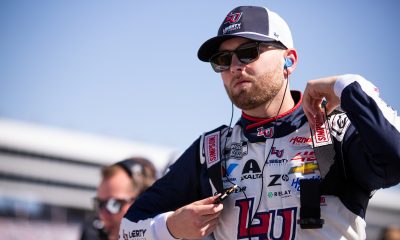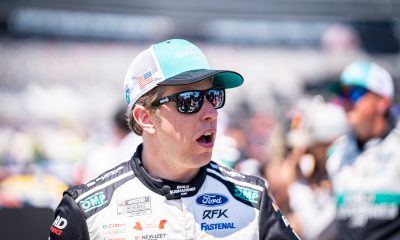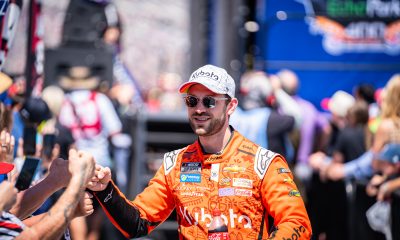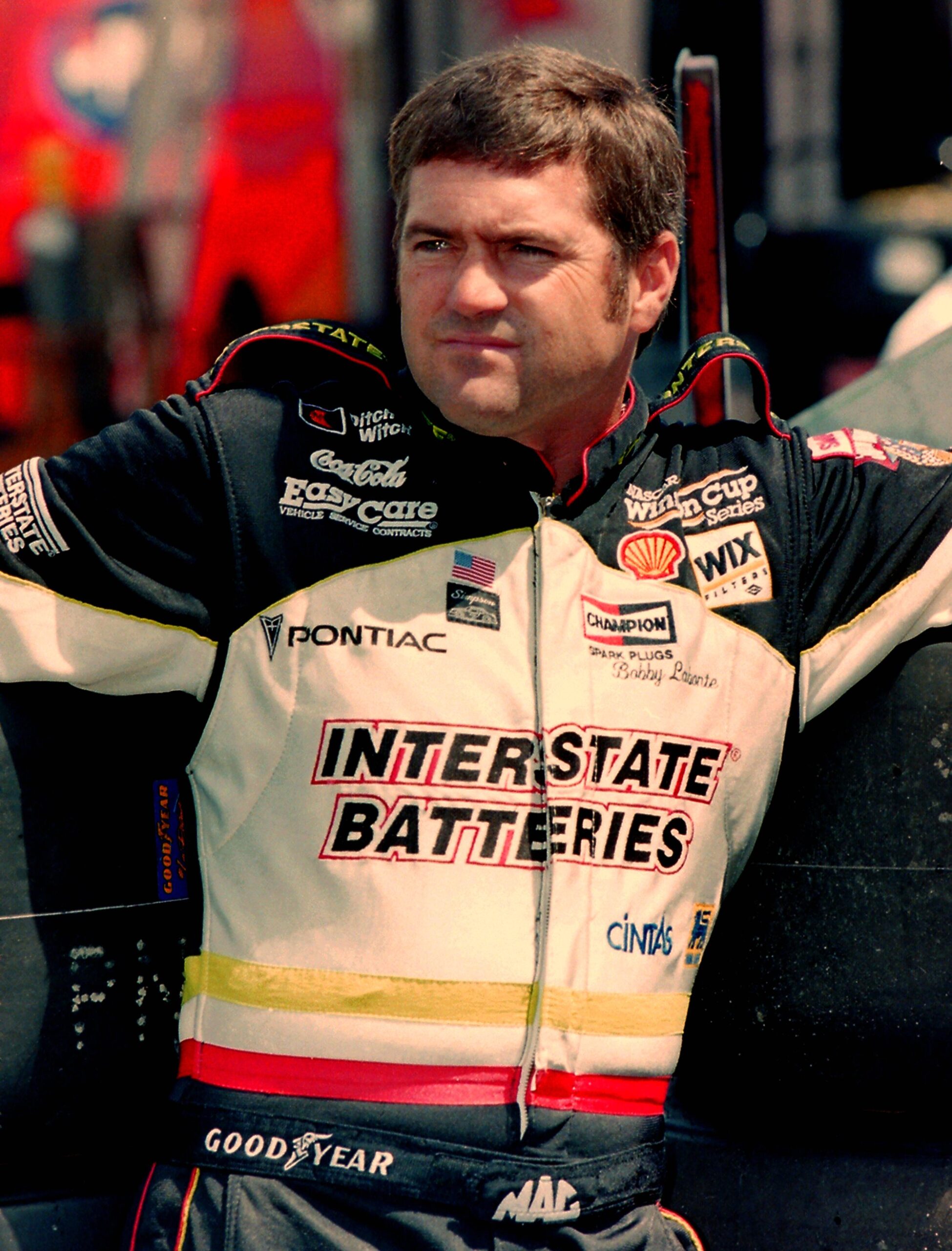
Bobby Labonte made a living “In the Hot Seat” for Joe Gibbs Racing’s No. 18 Interstate Batteries ride. (Photo: Darryl Moran)
If Dale Jarrett started Joe Gibbs Racing’s winning footprint, Bobby Labonte catalyzed the championship traditions of this perennial NASCAR Cup Series team starting in 1995. By all means, the Corpus Christi, Texas native found his winning form with Gibbs’s No. 18 Interstate Batteries Chevrolet and Pontiac entries from ’95 to ’05.
Before Labonte logged 21 wins, 26 poles, 115 top fives and 203 top 10 results in his Cup career spanning 729 starts, he cut his teeth in Texas. Once older brother, Terry, worked his way into Cup in 1978, the Labonte family moved to North Carolina.
Bobby Labonte had a few sips of coffee in NASCAR, including a stint as a fabricator for Billy Hagan’s racing team. Making sporadic starts in the NASCAR Xfinity Series in 1982, ’85, ’88 and ’89, Labonte embarked in his first, full-time effort in this division in ’90 with his family owned team.
After a solid fourth place points finish in ’90, Labonte went on to win the Xfinity Series championship in ’91 before placing runner up to champion Joe Nemechek by three points in ’92. Despite scoring five wins during his three full-time seasons in the second highest division of NASCAR, it was not an entirely smooth advancement into Cup by ’93 with Bill Davis Racing.
However, Labonte kept his head down, grinding out a top five and eight top 10 finishes for the fledgling No. 22 Maxwell House Ford and Pontiac entries fielded by Davis in ’93 and ’94. Solid, savvy with car setups and mild mannered, Labonte’s big break occurred ahead of the ’95 season when he was named as the driver of Gibbs’ No. 18 car.
From there, Labonte capitalized in emphatic fashion. Beyond the numbers, Labonte and his No. 18 team produced incredible NASCAR Cup Series memories.
Some of those moments included some brotherly appreciation such as the ’96 season finale at Atlanta Motor Speedway with Bobby’s race win and Terry’s second Cup championship or the ’98 Daytona 500 front row lockout. Most of the time, it was the younger Labonte displaying immense talent and a perfectly balanced attack against the dominant stars like Jeff Gordon, Mark Martin and Dale Jarrett.
Nowadays, Labonte is an analyst for FOX NASACAR. Making frequent appearances on NASCAR Race Hub during the season, Labonte’s cool, smooth approach on the track carries over into his works for FOX NASCAR.
Recently, I caught up with Labonte to talk about his recent racing efforts. While he hung up his Cup helmet in in ’16, the 57-year-old NASCAR Hall of Famer competes in modifieds and sim racing events. Additionally, he competed in the inaugural Superstar Racing Experience (SRX) season held over this past summer, placing third in the all-star series.
In the first of this two-part interview, Labonte delves into his early years of his NASCAR career and his big break with Gibbs. Without further ado, let’s get started with Part I of “In the Hot Seat with Bobby Labonte” here on The Podium Finish!
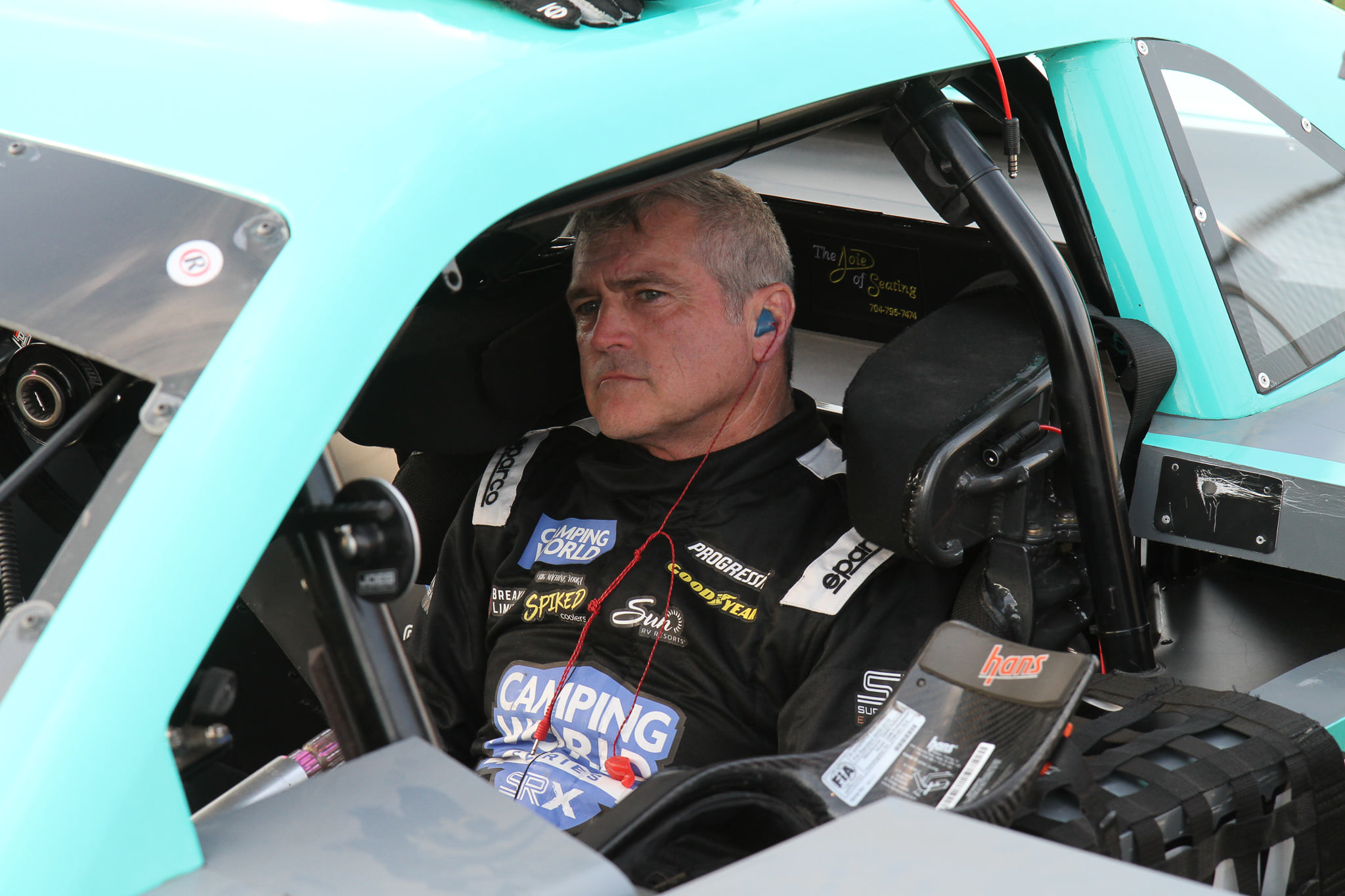
Bobby Labonte hasn’t missed a beat as he demonstrated with a strong showing the SRX. (Photo: Bobby Labonte | Facebook)
Rob Tiongson : Bobby, thanks for taking the time to talk to me today, and for The Podium Finish. Firstly, you’ve had quite a busy year. You’ve raced in modified cars, and you raced in the SRX series, with your analyst role alongside FOX NASCAR. So on the racing front, how exciting was it to race such different cars after your championship career in both the Cup and Xfinity Series?
Bobby Labonte : Yeah. I mean, it was definitely busy. The SRX cars were like a late model-ish, but yet not offset at all. So they were a little bit different, in a way. They were always a little bit tighter in the center of the corner, and the banked tracks were a little bit better for it. But everybody had equal cars, and we had equal… everything being equal, that was a blast. It really was. So for me to be able to have been invited to do that, loved it, the people, the racing. I mean, it was intense, and good. I mean, I can’t compare it to other cars I’ve driven, maybe, but… besides a late model.
And then driving the modified this year, another thing that I didn’t see myself doing until late last year. Those are a handful. I mean, I’m still a race fan. I still love racing, so. Both of those type of cars are different, but yet… yeah. I mean, it’s been fun and busy, and I’ve enjoyed doing both, for sure.
Tiongson : I love the fact that you called yourself a racing fan, because it seems like no matter what our role is in motorsports or NASCAR as a whole, we’re always going to be fans of the sport. So I mean, it’s been your life, basically, since you were here in Texas, and you’ve been in North Carolina since, I think, the mid- to late-70s.
Labonte : Mid-70s, yeah.
Tiongson : So I mean, from your perspective, with all the changes that’s happened, what always brings you back, besides the fact of your love of competition?
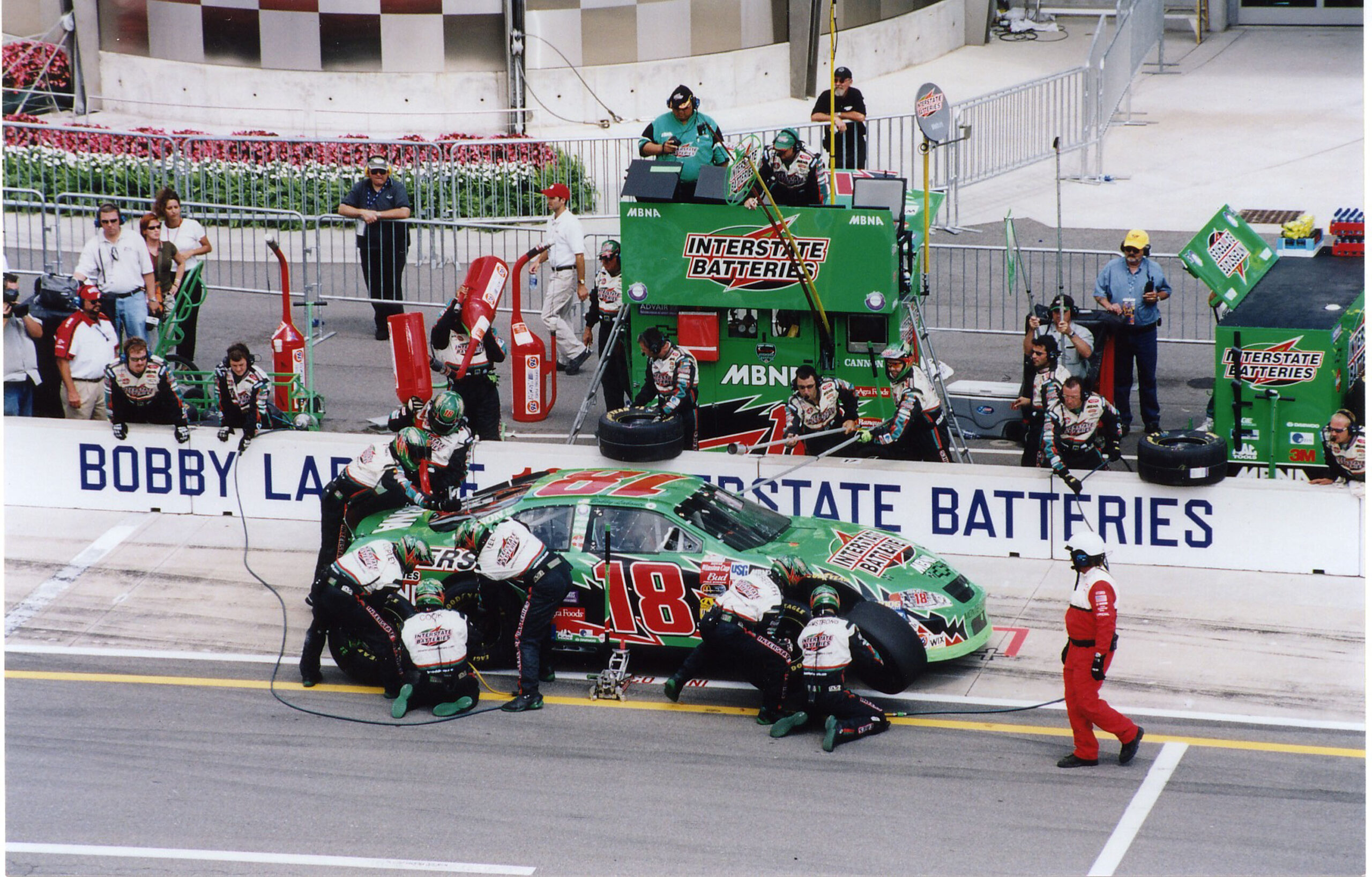
While Labonte has plentiful accolades from his Cup heydays, he’s a race fan just like you. (Photo: Russ Garcia)
Labonte : Well, I mean, it’s a lot of… I say a few things, which is a lot of things. But it’s a few things. I appreciate the fact that you notice that I’m a fan. And I can’t show you, but over there is my simulator. I was just running an F1 car at Monza, just trying it out. You know what I mean? So like, backing up, whether… last weekend, watching the Formula One race, I’m on the edge of my seat because, man, I’m excited about it. And then IndyCar racing, we do work there. The Cup races. I mean, I’ve called and I’m getting a spot at Martinsville so I can stay the whole weekend in the fall so I can watch everything, and hopefully we’ll race too. So, fan first and foremost.
To your point of the changes, I mean, I was probably the worst one that wanted a change in the schedule and the cars when I was racing, right? I didn’t want anything like that. And of course, now that I’m not doing that, I’m like, “Heck, yeah. Let’s change it. Go to the dirt track. Go to more road courses.” If it were me, I would have been complaining. But obviously, NASCAR… on one hand, you go, “All right, is this going to… how good is this going to be?”
But I do realize, as a fan, a geek, racer, that you can’t sit too long. I was wrong in wanting to sit too long. I would be that way. But knowing that their change really is going to be for the better, but a lot of times, you just… you’ve got to get used to it. But I think… obviously, NASCAR’s a lot smarter than me, so I feel like their changes are probably in the right direction, and you just have to follow it. And if you’re a fan, it didn’t matter, whether it’s the Jimmie Johnson days, or the Chase Elliott days today, or pulling for Kevin Harvick to beat the young guys, and all that.
So NASCAR making a lot of changes, I think, is great. I don’t always sit there and go, “That’s perfect.” But I think that the changes that they have made, are making, is necessary. We can’t put a Studebaker out there and expect yourself, non-race fans, to get involved. So they’ve got to be current, what you would drive currently if you were not a fan. You’d hope to have a Mustang or a Camaro in your driveway, and you want to watch it because it’s the same type of car.
So a lot of that stuff plays into it. So I think gaining new fans is what, obviously, we want to have, and to do that, we can’t race a Studebaker and things like that anymore. So it’s good. It just takes time for people to relate to it and understand it, and hopefully either become fans or stay fans.
Tiongson : Absolutely. I mean, we’ve seen changes throughout the course of NASCAR’s lifetime. I mean, I think back to before I became a fan, back in 1991, y’all had the change in ’81 where the cars got downsized. They weren’t as big and burly as they were. They became more what you would see on the streets, but then they became somewhat engineered. But as you’ve mentioned, we can’t be staying stagnant, and certainly, we don’t want it to become the Ford Explorer versus the Toyota 4Runner series. If that was the case, maybe I’ll be racing NASCAR. But we’ll keep it about you, of course, right now.
Now, you were named to the NASCAR Hall of Fame Class of 2020, which was an amazing honor, for sure, and off the record, you were one of my favorite drivers growing up. So you joined your long-time car owner, Joe Gibbs; your teammate and friend, Tony Stewart; legendary crew chief, Waddell Wilson; and of course, the late, great Buddy Baker, who we still miss to this day. What did it mean for you to be immortalized among these stock car icons?
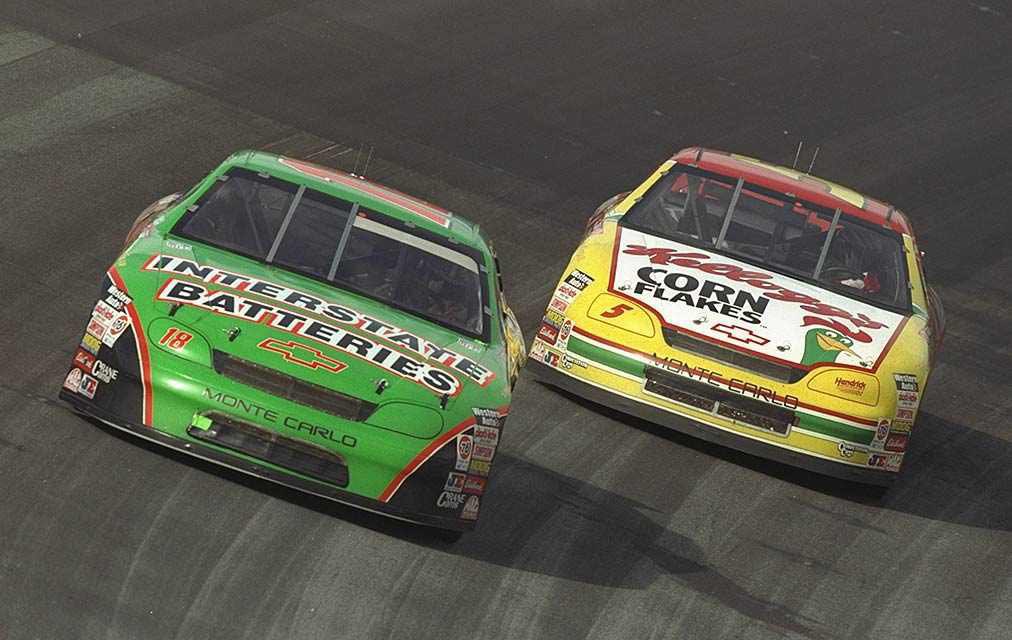
It was the Super Labonte Bros. show at Atlanta Motor Speedway in 1996. (Photo: NASCAR Memories | Twitter)
Labonte : Well, I mean, my older brother, obviously, Terry, being inducted years ago, just amazing. And to think that… I didn’t race Caraway Speedway and go, “Hey, I’m going to be in the Hall of Fame one day.” Obviously, it didn’t happen like that. But even later on, after I quit racing, it’s like, “Man, I don’t know.” I mean, if you get inducted, I mean, it’ll be a surprise, because you’re not sure.
It’s not a guarantee. I think about my parents. I mean, they’ve got two kids in the Hall of Fame. And I just think going into it, and then, to me, reflecting back, not just the group that I went in with, which was the best scenario of all of them with Joe and Tony, especially, and Waddell, knowing Waddell and knowing Buddy from years past.
For the three of us to go in, the Gibbs guys. But just all the other inductees. And I think after the induction announcement and then the ceremony, the time between the two, really reflecting on your career, your life, and all that stuff. That really hit home, because it’s like, you’re so busy. You’re living tomorrow. “I’ll get it tomorrow. I’ll get it tomorrow,” and you don’t think too far out.
And then this… that kind of made me think, of course, backwards, like, what did you do? What have you done? Who did you see along the way? The people you met, the people that helped you, your team, which is the main thing. Your family, and all that stuff. I mean, it was just so… I mean, I’ve got to take a breath and just go, “Whew.” I have done this for a long time. 50 years, you know? Racing quarter midgets.
So, yeah, it was just like, wow. I mean, you don’t know if you’ll ever get it, or get inducted, and I definitely didn’t think I was… didn’t know if I’d be for sure or not. But along the way, the people that helped you, your family, your friends, the heartache and the agony of defeat and the victory along the way, and the people that you met and are friends with that helped you along the way.
It’s just, all totaled, just a reflection back on your life. I think it was… I would have never thought that I would have reflected back on it, because I’m just busy every day. But that made me reflect back on it and see what all was accomplished, and what all you messed up on, too. So it was fun to reflect back on all the good stuff.
Tiongson : I was going to say, I’m sure you were not inducted just solely because you kicked your car at Bristol in ’96. I remember watching that. I was like, “Oh, no. Poor Bobby. I wish he had a better race.” But you definitely had a lot to be proud of with your career. And we’re going to take it back about 31 years ago. You talked about your beginnings at Caraway after moving from Corpus Christi to North Carolina, which I’m hoping to do myself at some point down the road.
You founded your own team, which today I think is super impressive in today’s NASCAR climate to even accomplish what you did. But in ’90, you finished fourth in points, and then the following year, you got the championship. And in ’92, you only lost by three points to Joe Nemechek. And I promise I’m not reading up on Wikipedia. I remember it all up here (in my head).
So when you think about your humble beginnings to getting to the Cup Series… well, before ’93, do you have a greater appreciation for what you were able to accomplish, given the level of competition back then and the hard work you had to put to own your own team and race that team.
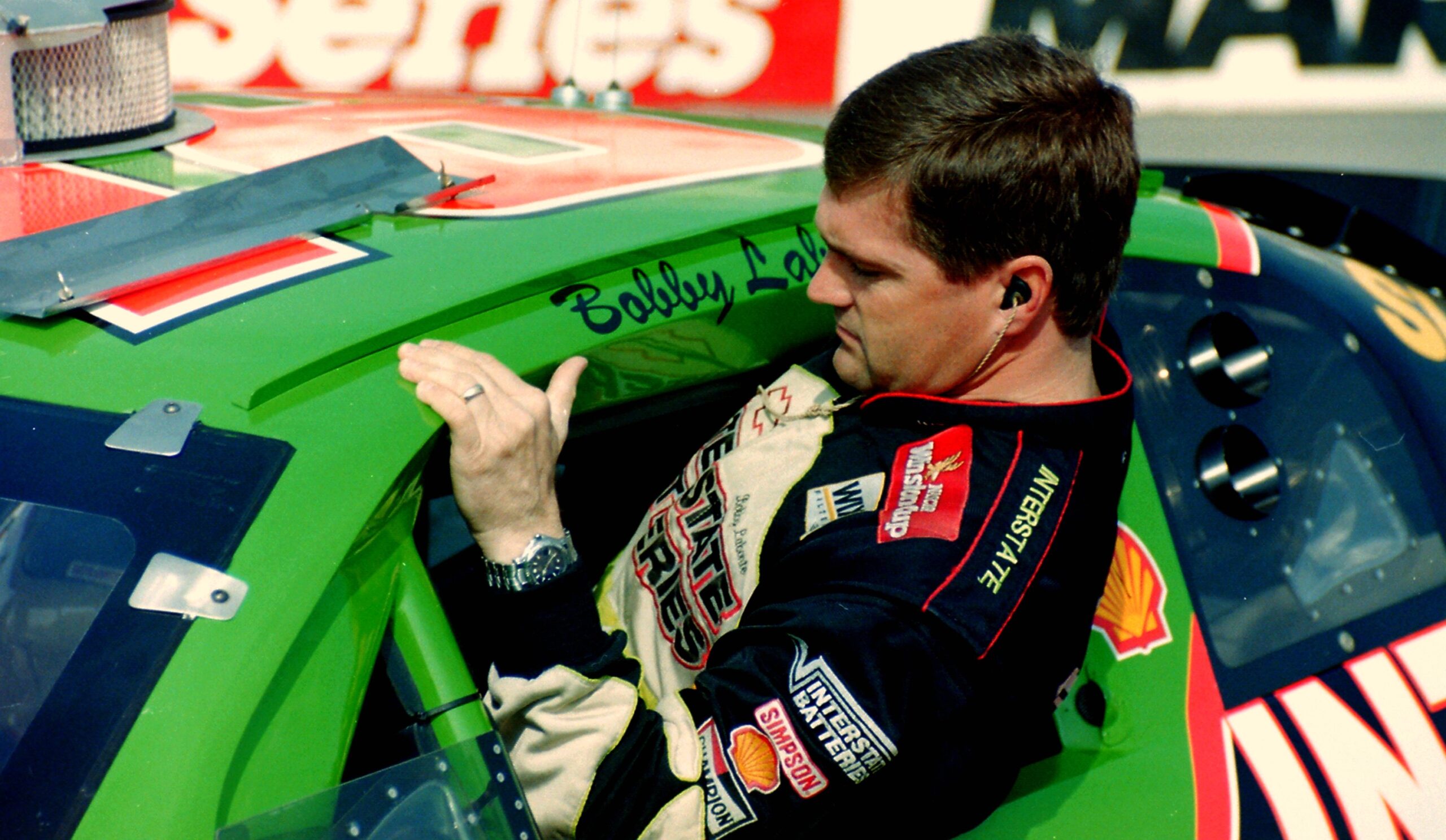
Labonte reflected on his storied stock car career. (Photo: Darryl Moran)
Labonte : Yeah. I mean, I really didn’t think I had… I mean, back then, owning your own team was a little bit, obviously, easier. And you didn’t really… I didn’t sit there and go, “Well, I’m going to drive for somebody.” It’s like, “Well, you’ve got to start somewhere,” and start with, and I’ve said this before, begging and borrowing and stealing. Basically, stock stuff like parts, pieces, bolted together, and build your car. And did that, and had a car.
Even in the mid-80s, early 80s, I had a late model that I couldn’t afford to race but once or twice a year, but I had my own car. And then it became that Busch Grand National team, and hiring people. I saw somebody the other day, they… in 1987, I worked for Jay Hedgecock and I raced my late model on the weekends, and in ’88, I went to work… basically, I was self-employed. So I’ve been self-employed since 1988, contract labor.
So yeah, that, to me, was kind of a defining moment. But it was just kind of like, I didn’t… I just never thought that I would drive for anybody else at that point in time. It was just like, I had to do my own. And when you think about it, I raced against Dale Earnhardt, and Harry Gant, and Ron Bouchard, and Dale Jarrett, and Mark Martin, and Terry, and Rick Mast, and Kenny Wallace. All those guys, and you look at what their career was like, whether they owned their own cars, or drove for their dad. Dale Sr. had his own car, and Darrell Waltrip. You know what I mean? I was racing against these guys. Heck, even Bobby Allison and Davey Allison. I mean, the list goes on about the people that I got to race with when I had my own team starting off.
So when you reflect back on it today, not the same environment. Harder to do. Almost impossible to do when you have mega teams. Back then, it was a lot more fun. I talked to Johnny Cash. It’s not the real Johnny Cash. It’s another Johnny Cash that worked on Jimmy Hensley’s car the other day, and we talked about it. “Tell Tommy Ellis I said hello, and blah blah blah.” And all those days back then, I mean, we all just kind of owned our own stuff. And Jack Ingram.
And I see pictures and I go, “Dear lord, that was awesome,” because we just kind of had our own stuff and we just had to race. And reflect back before that, like my dad. I mean, it was different then, too. But that was a great time, and it was awesome to be able to rattle off those guys’ names that I got to race with. Sam Ard. Brett Bodine. And all that stuff, and those series. Doing it the way we did it with just owning our own team, there’s definitely satisfaction in how we did it.
I mean, looking back on it, I feel like that was… I should be like 90, because that was dog years, because we aged quite a bit throughout all that. But, yeah. That was a great time. Again, it was just… kind of getting back to your question, I think. I mean, it’s definitely more satisfying here than maybe it would be if you just drove for somebody else and never showed up. And that’s easy to do today, and people do that, and they’re successful. But obviously having your own stuff, and managing and having and worrying about the next… the bills, you know?
It kind of makes you put it all together, and gratifying throughout all that. I wouldn’t want to do it again, but I’m glad I did it, because my parents brought me up that way, and that’s just kind of how it landed, and I’m glad we were successful at it.
Tiongson : Yeah. I mean, that’s a major takeaway that I remember from back then. Yeah, all you drivers owned your own equipment, which I think maybe also, to add to it, you appreciated to preserve your equipment and not… you didn’t have that luxury where, if you wrecked that car, well, you can always get it fixed and it comes back the next week. You have to be careful with it, too.
So I think, not that there isn’t respect these days on the race track, but I feel like more so back then, there was a sense of camaraderie and y’all being friends, but also separating that friendship from the off-track situation to what happened on the track, which I kind of miss, myself, as a fan and even as a journalist.
We’re going to fast forward a little bit here. Now, most fans are going to remember you as the 2000 Cup champion, which I will, because you won it in October. Well, the season had, what, two or three races left in 2000. But I mostly remember you because of ’95. I consider that your breakthrough year, which was so fun to watch you and Jeff Gordon battle it out at the big tracks.
So when you were named to drive the No. 18 car, owned by Joe Gibbs, did you realize how momentous that opportunity was going to be for you, especially with the fact that you won your first Cup race in the 600, and then again at Michigan?
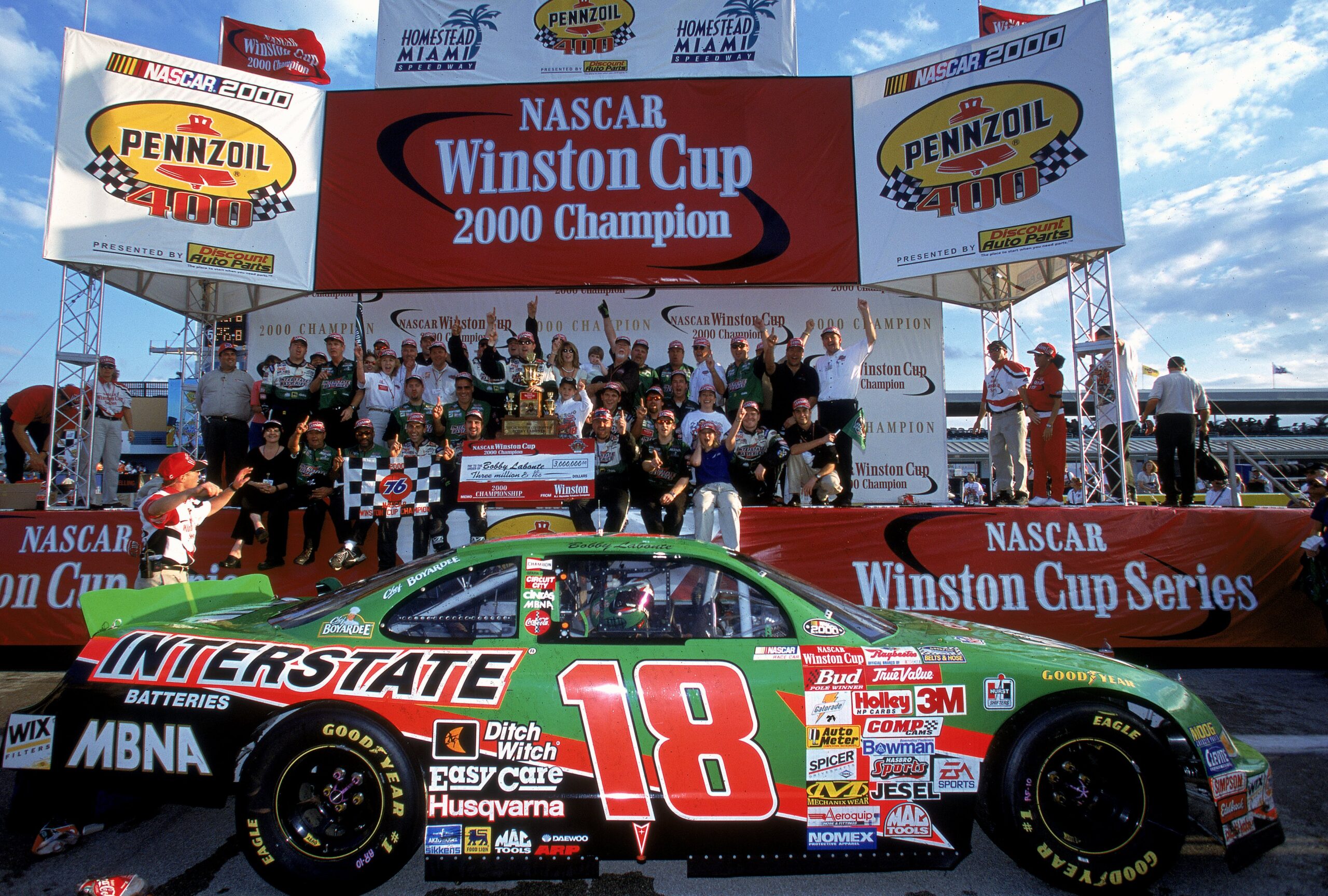
Those years of begging, borrowing and stealing paid off for Labonte in 2000. (Photo: Donald Miralle | Allsport)
Labonte : Yeah. I mean, obviously, when I went in there, it was a lot smaller back then. I was employee No. 18, I think, and the Christmas party had 25 people at it, right? And not 1,000 as of today, spouses included. And so I knew that it was good, but you don’t know how good it’s going to be. You don’t realize how good it’s going to be.
And then it didn’t take me long to figure out, hey, I went from kind of a… lost a sponsor with Bill Davis, and not sure, and didn’t know the future, what the future was going to be. Appreciate that step. And then when that happened, it was a… it just seemed like, when I sat in that car, I remembered how to drive again. I didn’t have to worry about 50 things. I just worried about three things and driving. So I didn’t have to process all that stuff, because I just was like, “Hey, drive. Okay.”
So that opportunity, again, it went from… when I was there and was there for 10 years, the growth of it was a straight line up almost, right? And I just think that that was golden for me, because got the right people with Jimmy Makar, got the right engines, got the right Hendrick Engines, got Mark Cronquist. From A to Z, having all the people there to support.
So I knew when we unloaded it. I knew before we unloaded at Daytona, we were going to be competitive, right? And I didn’t know it was going to be that quick, but we were just fast everywhere we went. I mean, it was just like an old shoe, man. Felt good. Just drive what you know and how you know it. But yeah, that was an amazing year. I never… in ’94, I’m like, “I don’t know if I’m cut out for this.” In my head, I’m going, “I’ve got to go back to the Busch Series, probably. Make my living there. Maybe, hopefully. I know I can race there.”
So, yeah. I mean, it was a small team at the time, but you knew the quality, knowing Joe Gibbs is going to be successful, but you didn’t know how it was going to be successful. So we started writing our story pretty soon after that because of how fast we were.
Tiongson : Those were amazing times to watch you in the No. 18 car, because ’95 and ’96 and ’97, ’98 to an extent, I mean, y’all did your best against theNo. 24 team. But from ’99 onward, it felt like there was so much diversity and parity in the field, and it was no surprise to see you not only mix it up at the superspeedways, but you became, I would say, pretty adept at the short tracks too, because one of your final Cup wins was at Martinsville in 2002, which was the beachball race, as I recall, on FOX. So I mean, it was just so fun to watch you back then.
Kind of a goofy question to that, have you ever figured out the shade of green that your Interstate Batteries car was?
Labonte : No, I don’t know the shade of green off the top of my head. I don’t know the PMS number. I know other PMS numbers. But I know that whatever Norman wanted design-wise, it was up to him to figure out how to design it. And that was what was really cool was him having his art degree and all that to design it. But, yeah. The green, all I don’t know. But all I know is it made me a lot of money, so I didn’t care. It was like, what’s under the hood and the rest of it, and the guys? Who cares. Let’s make money, and let’s race and win.
Tiongson : Absolutely. I love that green car, and funny story before I get to my last two questions. I brought your car to a… not show-and-tell. But when you’re a kid, you bring your toys to school in elementary school. So I brought your #18 car, and some kid bullied me, and I lost that car. And to this day, I can never find it. So I’m still scouring around for it on eBay and hoping I can find it so I can eventually say, “Hey, Bobby, I found your car!”
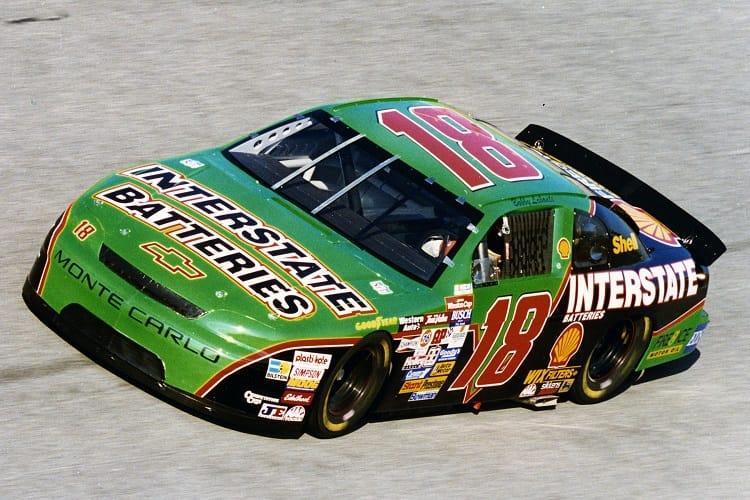
Labonte’s unmistakable No. 18 Interstate Batteries Chevy was a superspeedway fiend. (Photo: ISC Archives)
Labonte : Right, right. Let me know, yeah.
Editor’s Notes
Special thanks to Bobby Labonte and Megan Englehart of FOX Sports for making this interview possible! The conclusion of Bobby Labonte’s “Hot Seat” interview will publish on Tuesday, Dec. 21. Also, for the full, audio version of my interview with Bobby, check out Ep. 9 of The Podium Finish Live! on Spotify, Apple Podcasts and other major streaming platforms on Monday, Dec. 20!
Rob Tiongson is a 30-something motorsports journalist who enjoys sports like baseball, basketball, football, soccer, track and field and hockey. A Boston native turned Austinite, racing was the first sport that caught his eyes. From interviews to retrospective articles, if it's about anything with an engine and four wheels, it'll be here on TPF, by him or by one of his talented columnists who have a passion for racing. Currently seeking a sports writing, public relations, or sports marketing career, particularly in motorsports. He enjoys editing and writing articles and features, as well as photography. Moreover, he enjoys time with his family and friends, traveling, cooking, working out and being a fun uncle or "funcle" to his nephew, niece and cat. Tiongson, a graduate of Southern New Hampshire University with a Bachelor of Arts in Communication, pursues his Master of Arts in Digital Journalism at St. Bonaventure University. Indeed, while Tiongson is proud to be from Massachusetts, he's an everywhere kind of man residing in Texas.

